Using Monitor
Context
- Monitors play a central role in inference and analysis in BayesiaLab.
- Each Monitor represents (“monitors”) a corresponding node in the Graph Panel. However, beyond the passive monitoring of nodes, Monitors allow you to interact with nodes, for instance, by setting observations on nodes via the Monitors.
Usage
The following chapters explain all of the Monitors’ elements and how to use them.
States
A monitor can be in different states, depending on the type and the state of the associated node:
- normal: probability distribution of a chance node;

- hard evidence: the observed value is highlighted with the green bar;

- setting soft evidences : allows entering a likelihood for each state;

- soft evidences validated: after validating soft evidences with the light green button;

- setting probabilities: allows entering a probability for each state;

- likelihoods validated from probabilities: after validating probabilities with the light green button;

- fixed probabilities validated: after validating probabilities with the mauve button;

- target: probability distribution of the target node;

- target+** targetedvalue**: probability distribution of the target node within the framework of an adaptivequestionnaire** centered on a target value. The target value probability appears in light blue;

- temporal: probability distribution of a temporal father node (current time step);

- utility: expected value of the utility node and the sum of all the expected utilities (in bold). These values appear with their respective minimal and maximal values.

- decision: displays the probability distribution of the actions corresponding to a decision node (equiprobable except when descendant nodes are observed). The recommended action with respect to the context appears in light blue. This action corresponds to the one with the best-expected quality, quality that can be displayed by pressing the
 key while pointing on the monitor
key while pointing on the monitor

- notobservable**: there is no cost associated with the node, it won’t be proposed in the adaptivequestionnaire** and it won’t be observed in the interactiveinference**, the interactiveupdating**, the batch labeling and the batch inference.

- causal: probability distribution of a causal node.

Fix Current Probabilities
It is possible to quickly fix the current probability distributions of the selected nodes by using the Context Menu. All the selected nodes will have their own current marginal probabilities as fixed probabilities.
Negative Evidence Setting
It is possible to quickly indicate an impossible value (zero likelihood value) by maintaining the Ctrl key pressed while double clicking on the state that is impossible.
Selecting Evidence in the Evidence Scenario File
When an Evidence Scenario File is associated with the network, the icon is displayed in the network’s Status Bar. In validation mode, a right click on this icon displays a list of the evidence sets contained in the evidence file:
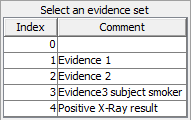
Simply click on one of the evidence sets in order to set the corresponding observations (if it is possible). This option is disabled in temporal networks and during interactive inference and updating.
Selecting Evidence in the Database
When a database is associated with the network and has Row Identifiers, a right-click on the database icon in the Status Bar, in validation mode, displays a panel allowing the user to perform a search among the row identifiers. The search is done thanks to a text field. The wildcards characters ? and *** can be used. ? can replace one and only one character. *** can replace none or several characters. The Case Sensitive option allows the search to respect the case. After pressing enter, the search is performed and the list of the results is displayed. The number of corresponding rows is displayed at the bottom of the panel. A click on a line sets the corresponding observations:
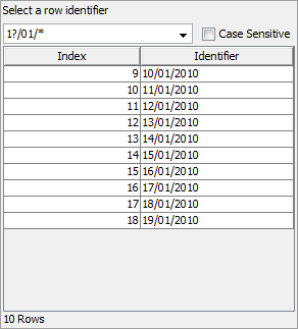
At each example, the nodes are observed with the corresponding value in the database except if this value is missing or the nodes are declared as not observable or as target. This option is disabled in temporal networks and during interactive inference and updating.
Soft Evidence Removal
Soft Evidence can be removed by using the contextual menu.
Target Node Definition
It is possible to define the Target Node and its Target State by holding the T key pressed while double-clicking on the Target State of the node. Double-clicking on the current Target State removes the “target” property from that node.
Node Centering
Pressing c key pressed while clicking on monitor, or on the selected monitor, allows centering the graph on the associated node and makes that node blinking during a few seconds.
Node Selection
Pressing x key pressed while clicking on monitor, or on the selected monitor, allows selecting the corresponding node.
Monitor List
The arrangement of the monitors inside the Monitor Panel can be reordered by simply dragging one or more selected Monitors and dropping them into the desired position.
Exact Probability Values
The probabilities that are displayed in the monitors can be rounded. When they are exact, they appear in bold. However, it is always possible to display the exact probabilities by using the shortcut![]() when focusing on the monitor.
when focusing on the monitor.
Probability Variation
This option allows visualizing the variation of the probabilities between each modification of the set of evidence.
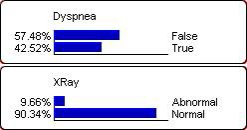
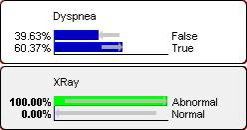
A double-click on the monitor, outside the state zone, or pressing the button allows resetting the arrows.
The button of the monitor’s toolbar allows specifying the current probability distributions as the reference state for the computation of the probability variation. The reset of the arrows is then unavailable.
The button displays the maximum positive variation and the maximum negative variation among all the states of all the nodes.
Displaying Computed Value
When a node has valuesassociated** withits** states, the resulting value, computed according to the probability distribution, is displayed. If the node doesn’t have any values associated, if the node is continuous the mean of each interval (computed from the data if a database is associated or the arithmetical mean is taken) is used, otherwise if the node is discrete with integer or real values, these ones are used. The option allows, as for the probabilities variations, visualizing the value variations between each modification of the evidence set. These variations are displayed at the right of the value.

Displaying Monitor’s Tooltip
By pressing the key l and moving the cursor over a monitor, a tooltip containing information about the monitor is displayed.
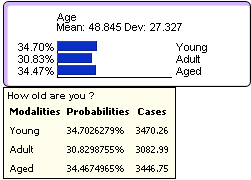
It contains the comment of the node if any or the name of the node if the comment is displayed instead of the name in the monitor. It contains a table with the states’ names as the first column, the corresponding probabilities as the second one, and the number of cases each state represents according to the evidence. This last column is displayed only if a database is associated with the network.
Copy & Paste
Monitors can be copied and pasted to external applications. They can be pasted as images or data arrays in plain text or in html format. In addition to the probabilities, the mean, standard-deviation, and value are also copied if they are present.
Zoom
The Zoom level of the Monitors can be changed with the corresponding buttons in the Monitor Toolbar.
